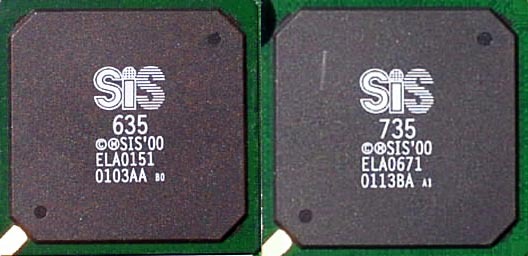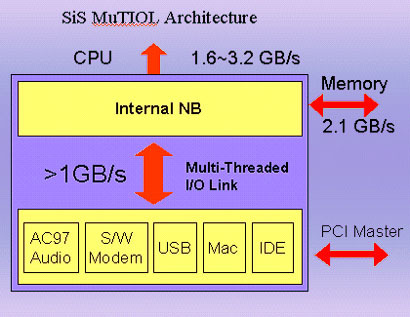There's No Stopping Them: SiS Beats AMD & Co
Sensation: SiS 735 Beats AMD 760
Our latest tests left us almost speechless. The SiS reference board - sporting the brand new SiS 735 chipset - clearly beats the competition with the AMD 760 module in terms of performance. More than that, the SiS reference is impressive due to its perfect system stability, something previously unheard of from this Taiwanese manufacturer. So with its 735 chipset the wilting wallflower usurps the throne once occupied by the AMD with its 760, and dons the performance crown. This is a fact for which many will need time to digest.
And yet the story behind SiS does not reveal an exemplary company with a good grasp of the upwardly mobile end-user market. For the past 10 years, starting from the days of 486 PCs, this manufacturer has only been serving project customers to build budget-priced boards with integrated graphics for low-cost systems. To ease its conscience, SiS has made half-hearted attempts every two years to gain a foothold in the end-user market. However, their chipsets could stand up to the competition in only one respect: price. Otherwise, boards carrying the SiS logo were typically characterized by poor performance, faulty device drivers and high support costs for motherboard manufacturers. Quite a few board manufacturers even decided not to use SiS chipsets at all for a while.
Newcomers: 635 and 735 from SiS with DDR-SDRAM-Support, Ultra-DMA/100 and 6 x USB.
It remains to be seen whether or not SiS knows how to position the 735 chipset correctly in the market and to make it attractive for motherboard manufacturers. In any case, the old argument - that price is the only deciding factor - is now history. We have subjected both of the new SiS chipsets with DDR support to extensive testing: the SiS 635 for all Intel processors and the SiS 735 for the AMD platform.
Single-Chip Technology: SiS 735 And SiS 635
From a technical point of view, the Taiwanese manufacturer can be proud of its achievements. Both the new chipsets, the 735 and the 635, consist of only one chip. Whereas the AMD, ALi, Intel and VIA modules are each made up of a North Bridge and a South Bridge, SiS has managed to incorporate all the functions into one chip. This design has some distinct cost advantages: additional resistors and capacitors are no longer required, and in addition, it costs less to produce a single, highly integrated chip in large numbers than it does to produce two different, less well integrated ICs. On top of that, single-chip technology saves space, makes for a less cluttered board and provides for shorter signal paths.
Schematic illustration of the 635-/735-chipset from SiS. In this module all the functions are integrated into a single chip.
| Chipset | SiS 735 | AMD 760 | VIA Apollo KT266 | ALi Magik 1 | VIA Apollo KT133A |
|---|---|---|---|---|---|
| Launch | May 2001 | February 2001 | April 2001 | February 2001 | January 2001 |
| Processor Platform | Socket 462 | Socket 462 | Socket 462 | Socket 462 | Socket 462 |
| CPUs supported | AMD Athlon/Duron | AMD Athlon/Duron | AMD Athlon/Duron | AMD Athlon/Duron | AMD Athlon/Duron |
| Multiprocessor Support | no | no | no | no | no |
| Chipsatz Northbridge | SiS 735 | AMD 761 | VIA VT8366 | ALi M1647 | VIA VT8363A |
| Chipsatz Southbridge | - | AMD 765 | VIA VT8233 | ALi M1535D+ | VIA VT82C686B |
| Front Side Bus Clock | 66/100/133 MHz DDR | 100/133 MHz DDR | 100/133 MHz DDR | 100/133 MHz DDR | 100/133 MHz |
| Memory Clock | 66/100/133 MHz DDR | 100/133 MHz DDR | 100/133 MHz DDR | 100/133 MHz DDR | 100/133 MHz |
| Asynchronous Memory Clock | yes | yes | yes | yes | yes |
| 33 MHz PCI at 133 MHz FSB | yes | yes | yes | yes | yes |
| FSB Overclocking * | up to150 MHz | up to150 MHz | up to166 MHz | up to150 MHz | up to180 MHz |
| max. # DIMM or RIMM Slots | 3 | 4 | 4 | 4 | 4 |
| max. Memory | 1536 MB | 2048 MB | 2048 MB | 1024 MB | 1536 MB |
| SDRAM Support | yes | no | yes | yes | yes |
| DDR SDRAM Support | yes | yes | yes | yes | no |
| VC SDRAM Support | no | no | no | no | yes |
| RIMM Support (Rambus) | no | no | no | no | no |
| Ultra-DMA/33/66/100 | yes/yes/yes | yes/yes/yes | yes/yes/yes | yes/yes/yes | yes/yes/yes |
| Max. # USB Ports | 6 | 4 | 6 | 6 | 4 |
| Max. # PCI Slots | 6 | 6 | 6 | 6 | 6 |
| Integrated Graphics Core | no | no | no | no | no |
| AGP 1x / 2x / 4x | yes / yes / yes | yes / yes / yes | yes / yes / yes | yes / yes / yes | yes / yes / yes |
| ACPI Features | yes | yes | yes | yes | yes |
* depends on clock generator
Get Tom's Hardware's best news and in-depth reviews, straight to your inbox.
Comparison of all the important chipsets for AMD Athlon/Duron for socket 462.
Progress is also evident in the details. Neither a heat sink nor a fan are required for the chipset (735 and 635). The chip, with its large surface area, remains remarkably cool when in operation, while its competitors AMD and VIA fuss with heat sinks and humming fans.
Current page: Sensation: SiS 735 Beats AMD 760
Next Page Single-Chip Technology: SiS 735 And SiS 635, Continued

